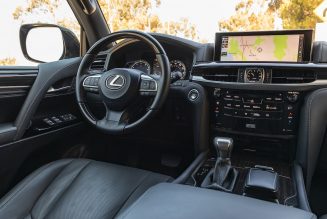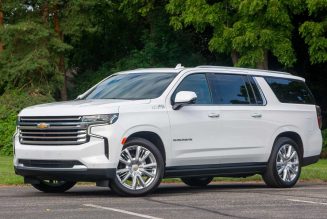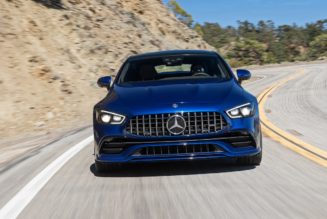Thanks largely to Tesla, manufacturer of the quickest car we’ve ever tested, we’ve come to expect great rapidity from electric vehicles. But if EVs are going to become mainstream (and both governmental and automaker pledges indicate that is going happen eventually, ready or not), then they can’t all be high-priced rocket ships for early adopters. Enter the 2021 Volkswagen ID4, the electric ambassador for the post-“Dieselgate” VW. The ID4 is meant to be a true volks wagen, an everyday SUV for everyday drivers. It’s sized, powered, and almost priced to match conventional compact SUVs such as the Honda CR-V and Toyota RAV4.
2021 Volkswagen ID4 by the Numbers
We’ve got lots to tell you about the new 2021 VW ID4, most of it good, but let’s start with our performance numbers. We tested the rear-wheel-drive model, which uses a 201-hp, 229-lb-ft electric motor mounted at the rear axle. Our ID4 hit 60 mph in 7.4 seconds and ran the quarter mile in 15.9 at 86.3 mph, comparable to a Honda CR-V and 1.5 seconds quicker than the last Volkswagen Tiguan we tested. The ID4 doesn’t slam you back in your seat with tire-shredding torque like that record-setting Tesla, but it accelerates smoothly and steadily right up to freeway speeds.
We question the choice of rear-wheel-drive for a mainstream crossover SUV, though. Despite the inherent coolness of a rear-motor VW, we think Mr. and Ms. America would prefer something more sure-footed in the snow, but we hoped it might pay some dividends in the real world. Separating power and steering across the front and rear axles has advantages. For instance, the ID4’s turning circle is ridiculously tight, and the steering feels eager and accurate. On both the figure-eight test track and our favorite curvy roads, we could feel the tail trying to step out, but the stability control always stopped it. (We never did figure out how to turn the nanny off, but this VW-produced video of Tanner Faust caning the ID4 implies it can be done.)
The heft of the battery pack under the floor certainly helps with the 2021 Volkswagen ID4’s stability, though it sometimes hinders ride quality. The ID4 is smooth and comfortable in most circumstances, but on poorly paved streets it jiggles and jostles, a consequence of the damping stiffness required to keep 4,659 pounds of ID4 from flailing out of control.
The shocks are generally successful in this endeavor, but on curvy roads, we found that a good, hard bump taken at speed could send the ID4 into oscillations the suspension had a hard time reining in. If such a bump happened to be in the middle of a fast corner, it made for a wild ride. Still, everyone from our team who drove the ID4 enthusiastically said they had a better time than they were expecting.
2021 Volkswagen ID4: Regen and Range
One thing we really liked during our test drives was the battery-power-generating braking setup. The VW ID4 only has one selectable level of regen (accessed from shifting from D to B), which we thought wouldn’t be enough; in our experience, the Hyundai Kona Electric‘s setup, with multiple driver-selectable levels of regen, is the best solution. Much to our surprise, the VW ID4’s single setting turned out to be just right, slowing the car appreciably but not aggressively or to a degree that forced a major adjustment to our driving styles.
And what of range? Like its acceleration, the ID4’s EPA-rated 250 miles is not the stuff of headlines, but it’s an honest number. In ordinary driving, including quite a bit of time on the freeway (generally a range-sponge for EVs), we found the ID4 eagerly met or slightly exceeded this figure. More aggressive driving clipped our range by about 10 percent, but we don’t test cars or scream through the curves every day, and an overnight charge was sufficient for four or five days’ worth of ordinary driving. A 300-plus-mile figure would give the ID4 bragging rights, but for electric-car owners charging at home, the ID4 need cause no range anxiety.
2021 Volkswagen ID4: Brace Yourself for the Future
If the ID4’s performance was pleasantly ordinary, the way it presents itself is anything but. Let’s start with the exterior styling, a familiar two-box SUV shape shaved and sanded to slip through the air. The 2021 Volkswagen ID4 is about the same length and width as a Honda CR-V or a Toyota RAV4, but it sits quite a bit lower, the better to cheat the wind. From the outside, the VW ID4 strikes us as something we’d see in a movie set in the not-too-distant future.
The interior made us feel more like we were part of the cast. Volkswagen cabins have been remarkably consistent for the last couple of decades, to the point that when VW finally went to digital dashboards, it basically recreated its trademark analog gauges in video form. With the ID4, tradition goes right out the window along with the internal combustion engine. Warning to the Veedubisti: Before you hop into an ID4, brace yourself for some major culture shock.
The 2021 VW ID4’s gauge cluster is now a small video screen that perches atop (and moves with) the steering column. Like VW’s traditional analog dials, it distills lots of useful info into a simple format: speed, range, driver-aid status, and (optionally) next-turn directions. It’s all presented in a manner that reminds us of a really good head-up display. Jutting out from the pod’s right side is the simplified shifter: twist for a Drive, Reverse, or Neutral, and push for Park. On the limited-run 1st Edition model we tested, the steering column, wheel, and all its attachments were done up in dirt-magnet white, but other models will have a more conventional dark-gray scheme.
2021 Volkswagen ID4: Learning Curve or Learning Curb?
Nearly all other controls—stereo, climate, phone, and settings—reside on the tablet-like center screen (10.0-inch display standard, 12.0-inch optional), which has a capacitive touch panel below it to change temperature and volume and quickly access the parking camera, climate control settings, driver-assist settings, and drive-mode screens. Steering wheel buttons play an important role, as they should, but locating the defroster switches with the headlamp controls on the same panel to the left of the wheel is a head-scratcher.
We have no doubt the new control system will be a lightning rod for complaints, particularly from car reviewers like us. Truth told, we were all set to bash the system after our first day of using it, but we soon found the learning curve, while steep, isn’t very high. The touch-sensitive “buttons” can be a little confusing; some activate via swiping and some need to be pressed, and some provide haptic feedback and others don’t. We found the ID4’s new interface is a bit like visiting a country where the citizens speak English with a strong, different accent: Once you get an ear for it, everything mostly makes sense.
Kudos to VW for incorporating a little Tesla-like magic in the startup sequence. There’s a start button on the steering column, but you need not use it; once you’re inside the car—with the key on your person, of course—stepping on the brake turns the powertrain on. Twist the dial for D, and away you go. Turning it off is even cooler: Put the car in park and open the door, and everything shuts down as you get out.
2021 Volkswagen ID4: Pricing and More—Is It Worth It?
In terms of interior and cargo space, the ID4 delivers about as much of the former and almost as much of the latter as you’d expect from its gasoline-powered competitors. All the seats are comfortable and reasonably roomy, but cargo space suffers a bit from the ID4’s swept roofline.
Key to accessibility is affordability. Volkswagen says the average price paid for a compact SUV (luxury or blue-collar) is $33,000, which was its post-incentive price target for this EV. The 2021 VW ID4 starts at $41,190, for which you get cloth seats, dual-zone climate control, and automatic headlights and wipers. Subtracting the $7,500 tax credit brings the price down to $33,690, and state incentives may further lower the figure. Also, let’s not forget the costs of home charging are negligible compared to fueling a thirsty SUV.
Prices rise sharply from there on out. When all-wheel-drive arrives later this year, with two motors and more power (but presumably less range, as it uses the same battery pack), it’ll cost $3,680 extra. An AWD ID4 Pro S with all the trimmings will set you back nearly $51,000, which is Tesla Model Y territory, though Tesla’s federal tax incentives have run out and VW’s haven’t. But the limited-run ID4 1st Edition is a good one-time bargain, offering all the trimmings of the rear-drive Pro S for just more than $45,000 before incentives.
We came away impressed by the 2021 Volkswagen ID4, an electric SUV with one set of tires in the present and one in the future. It’s good fun to drive, novel but not baffling, and most important a reasonably practical SUV. If this is what mainstream EVs will be like in the not-too-distant future, then the future might not be as dark as you think.
| 2021 Volkswagen ID.4 1st Edition | |
| BASE PRICE | $45,190 |
| PRICE AS TESTED | $45,190 |
| VEHICLE LAYOUT | Rear-engine, RWD, 5-pass, 4-door SUV |
| MOTOR | 201-hp/229-lb-ft permanent magnet electric |
| TRANSMISSION | 1-speed automatic |
| CURB WEIGHT (F/R DIST) | 4,659 lb (47/53%) |
| WHEELBASE | 108.9 in |
| LENGTH x WIDTH x HEIGHT | 180.5 x 72.9 x 64.4 in |
| 0-60 MPH | 7.4 sec |
| QUARTER MILE | 15.9 sec @ 86.3 mph |
| BRAKING, 60-0 MPH | 119 ft |
| LATERAL ACCELERATION | 0.83 g (avg) |
| MT FIGURE EIGHT | 27.4 sec @ 0.61 g (avg) |
| EPA CITY/HWY/COMB FUEL ECON | 104/89/97 mpg |
| ENERGY CONS, CITY/HWY | 32/38 kWh/100 miles |
| CO2 EMISSIONS, COMB | 0.00 lb/mile (at vehicle) |









